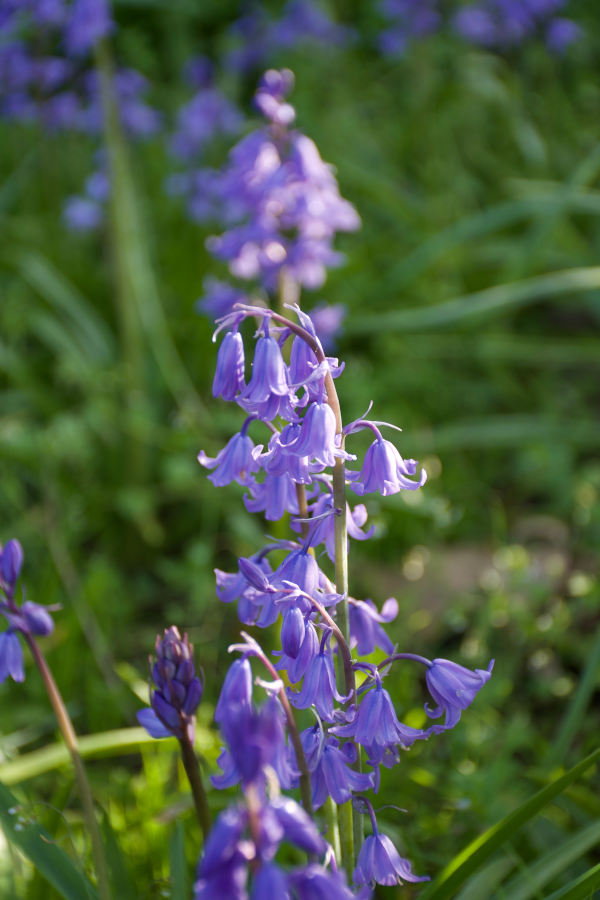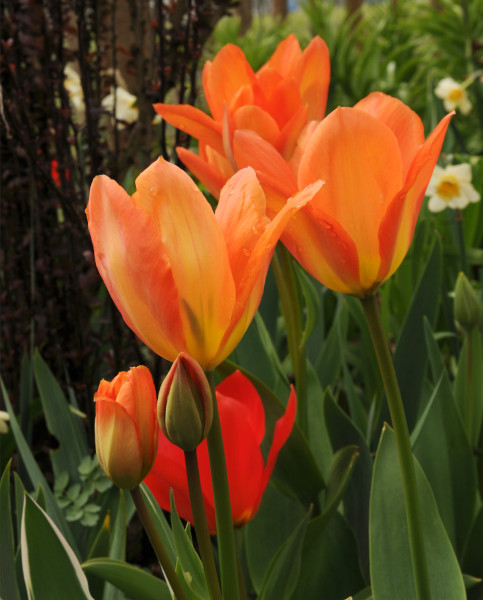How to grow Hyacinthoides
The common bluebell is one of the nation’s spring favourites. Perfectly sculpted flowers will greet you each springtime as you welcome their abundance and colour with open arms.
Hyacinthoides are bulbous perennial plants with elegant strap-shaped leaves and bell-like blooms that are perfect for groundcover purposes, quickly naturalising to create a carpet of colour. Found all over Britain, Hyacinthoides create the much loved ‘Bluebell Woods’ in spring, which are often ancient woodlands that date back several hundred years. However, Bluebells do not need woodland, and will thrive in grassland and hedgerows.
Hyacinoides non-scripta is the common bluebell, also known as the English Bluebell. Nodding, tubular blooms, often in dark blue shades, hang in racemes on just on one side of the stem, giving it the iconic drooping stature. The petals are strongly recurved at the tip, while the blooms have white pollen and emit an unforgettable fruity, sweet, almost honey like scent.
Hyacinthoides Hispanica is the more vigorous cousin, known also as the Spanish Bluebell. Native to the Iberian peninsula, it is more robust in stature with wider leaves and larger, paler, flared blooms all around the stem and very little or no scent. Since introduction to Britain, it has hybridised with the common bluebell to form the invasive Hyacinthoides x massartiana, which is believed to be a threat to the British native flower.
Also known by the common names Wood Hyacinth, Wood Bell and Fairy Flower, bluebells are well known for their love of a shady woodland setting, but they will also happily grow in borders and containers in any style of garden scheme, given the correct environment.
Full of nectar, the nodding blooms are loved by many of our pollinating friends, bees, butterflies and moths just to name a few with visit for an early feast. In the language of flowers, Bluebell is said to symbolise humility, gratitude and everlasting love. Bluebells are dedicated to St George, the patron saint of England and it is said that if you wear a wreath of bluebells you will only be able to speak the truth. The root sap was once used to glue arrows and for binding books.
Bluebells make excellent cut flowers, lasting well in a vase or in a posy, especially as it is the birth month flower for April.

Key Information
Soil pH
Position
Hardiness


Where & when to plant Hyacinthoides
Position Part shade
Soil Moist, well-drained
Flowering Spring
Hardiness Hardy to fully hardy (dependant on variety)
Hyacinthoides grow happily in sun or part shade but prefer to be out of strong sunlight. Plant your bulbs in autumn in moist, humus-rich, well-drained soil. If you are not ready to plant your Bluebells when you receive them, store in a cool, dry, well-ventilated place in temperatures between 4-20°C.
Bluebells are best positioned in an area of part shade, preferably below a canopy of trees or shrubs where cooler conditions will help to intensify the colours. If necessary, add a good amount of well-rotted manure or other organic matter to your soil to prevent it from drying out in summer.
How to plant Hyacinthoides
Hyacinthoides grow happily in sun or part shade but prefer to be out of strong sunlight. Plant your bulbs in autumn in moist, humus-rich, well-drained soil. If you are not ready to plant your Bluebells when you receive them, store in a cool, dry, well-ventilated place in temperatures between 4-20°C.
Bluebells are best positioned in an area of part shade, preferably below a canopy of trees or shrubs where cooler conditions will help to intensify the colours. If necessary, add a good amount of well-rotted manure or other organic matter to your soil to prevent it from drying out in summer.
Hyacinthoides are best when planted as a clump, or in a drift. For a natural look, take a handful of bulbs and gently throw them, as if skimming a stone, and plant each bulb where it lands.
Dig a hole that is around 8cm deep, spacing each bulb around 10cm apart. Place in a bulb, pointed end upwards and the back fill in with soil. Water the area well after planting to settle the bulbs and the soil into place. If planting Hyacinthoides in a container, use a good quality compost and plant the bulbs as above, but they can be a little bit closer, as long as they do not touch each other or the side of the container.
Please take care when handling Hyacinthoides, as they are toxic if ingested. We recommend you wash your hands after handling any ornamental bulbs.

What to plant with Hyacinthoides
Perfect to add spring colour to a tricky, shady spot in your garden, a carpet of Bluebells is hard to beat. Especially when contrasted against the bark of silver birch trees.
Create your very own Woodland area by combing Bluebells with other shade loving spring bulbs like Snowdrops and Winter Aconites, you could also add Epimedium and Anemone blanda.
Another woodland angle would be to grow with ferns, which will detract from and hide the yellowing foliage after flowering and keep the ground moist and shaded over the heat of summer.
Hardy perennials such as Geranium will sprout as your Bluebells are fading and will fill the areas that the Bluebells once took.
Create colourful spring containers by combining Bluebells with other spring flowering bulbs like Narcissi, Crocus and Tulips, which will contrast in flower shape, above primroses and pansies.



How to care for Hyacinthoides
Unless grown in a container that can easily dry out quickly, Hyacinthoides rarely need watering other than during excessively dry summers. Ensure the soil is damp but not waterlogged as this can cause bulbs to rot.
Before new shoots emerge in spring, apply a well-balanced fertiliser to the soil.
After flowering, apply a general purpose, liquid feed. Remove the faded flowerheads but please leave the foliage in place after flowering to allow it to continue to photosynthesise, gathering nutrients and energy to store back in the bulbs, ready for the following season. Only remove once they have turned yellow.
Hyacinthoides will naturally divide and spread to create a clump, making bulblets below the soil. These clumps can be lifted, divided and re-planted every few years in summer, this will help to avoid congestion and also to make new plants in other areas of your garden. It is also possible to propagate Hyacinthoides by seed that can be sown in pots within a cold frame. The seed can take up to 6 months to germinate and will probably not be mature enough to flower for several years.
Rarely troubled by any pests or diseases, Hyacinthoides are hardy to around -30°C, so generally require no winter protection from cold and will return again to flower for many years.
How to propagate Hyacinthoides
Hyacinthoides will naturally divide and spread to create a clump, making bulblets below the soil. These clumps can be lifted, divided and re-planted every few years in summer, this will help to avoid congestion and also to make new plants in other areas of your garden. It is also possible to propagate Hyacinthoides by seed that can be sown in pots within a cold frame. The seed can take up to 6 months to germinate and will probably not be mature enough to flower for several years.




